| |
Traveling Film Festival in Orissa: Environment-Beyond
Trees And Tigers
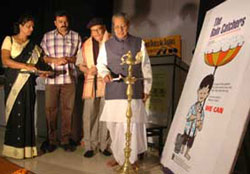
Shri
Biswabhushan Harichandan, Minister for Rural Development, Industries
and Law, govt of Orissa inaugurating the film festival |
A traveling film festival was organized by the Centre for Science
and Environment (CSE) in association with Sambalpur-based Manav Adhikar
Seva Samiti (MASS) in Bhubaneshwar, Orissa on November 30-December
1, 2005.The objective of the programme was to develop interest among
people on environmental issues. The festival held at Soochna Bhawan
attracted thousands of peoples including students, teachers, NGO's
government officials and environmentalist where a variety of events
were organised like screening of films environmental issues, panel
discussion and drawing competition for children and film release.
Ranjan Panda, Secretary of MASS, speaking on the objective of the
festival said "this is the first ever such event and Orissa's
emerging environmental problems had made it almost necessary to organize
such an event".
Minister for Rural development, Industries and law, Shri Biswabhushan
Harichandan inaugurated the festival and called upon the people of
Orissa to make use of the rare opportunity and watch the fascinating
films. Earlier Pradeep Saha, Associate Director of CSE, in his keynote
address deliberated on the need of environment in a broader and integrated
perspective and explained why the title of the festival is "Environment
- Beyond Trees and Tigers". The films screened during the event
covered broad environmental issues including Climate Change, Water
Management & Rainwater Harvesting, Sustainable Livelihood, Waste
Management and Wildlife Conservation. 'Drinking the Sky' speaks about
water management, 'The Ridley's Last Stand' which focuses plight of
the Olive Ridleys of Orissa coast, 'Changing Climates: The Impact',
which travels to Africa, Asia and North America searching evidence
on climatic changes, 'Changing Climates - The Future' which showcases
technology available and new technologies that generate sustainable
power from clean and renewable sources, 'The Village Republic', which
revolves around villages who have dared to take control of their environment
into their own hands and change their economic fate, 'Oozy Ozone'
which speaks about depleting ozone layer, impacts of Ultraviolet rays
on human health and ways to prevent destruction of the ozone layer
were also screened. Spread over two days, total nine films were screened
during the festival and saw a tremendous response from people including
children.
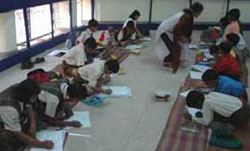 School
children participating in painting competition
School
children participating in painting competition |
A painting competition was also organised for children on "Natural
disasters" in a bid to develop interest among school children
towards environment. Over 50 children participated in the competition
from various schools and produced some lovely paintings, which were
later put on for display at the festival venue. The first three best
paintings of the competition were awarded the prize along with some
consolation prizes. Thrilled with the response of visitors in the
festival, Kiran Pandey, coordinator-audivisual unit unveil that "We
are trying to make it a regular event and are planning to take it
to other towns also".
Seminar for teachers on Environment Education at Megpai, Faridabad
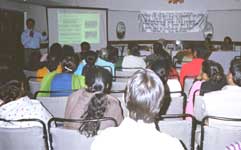
Salahuddin Saiphy, CSE during seminar on Environmental Education |
On December 13, 2005, About 85 teachers from government and public
schools of Faridabad attended a workshop on environment education
held at Megpai Restaurant, Sector 16-A, Faridabad. The seminar was
organised in association with a Japanese International Organisation,
OISCA- International (Organisation for Industrial, Spiritual and Cultural
Advancement), North India. The participants were exposed to various
environmental issues by Japanese representatives and experts from
India. The sessions include Children -Forest Programme and Action
Handbook for teachers, solid waste management and rainwater harvesting.
The 90 seconds public service advertisement on rainwater harvesting
produced by Centre for Science and Environment was also screened on
the occasion.
CSE releases "The Rain Catchers - a practical guide to solve
your water problems"
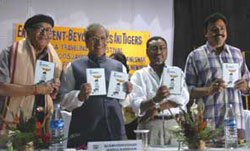
Shri
Biswabhushan Harichandan, Minister for Rural Development, Industries
and Law, govt of Orissa releasing film “The Rain
Catchers” |
In a packed out auditorium, Minister for Rural Development, Industries
and Law, Shri Biswabhushan Harichandan released CSE's latest film
on water "The Rain Catchers - a practical guide to solve your
water problems" on November 30, 2005 at Soochna Bhawan, Bhuvaneshwar,
Orissa.
CSE's latest production on urban rainwater harvesting "The
Rain Catchers" which was released in a public meeting in Bhubaneshwar
received accolades and appreciation from all sections of viewers.
CSE staffer also made a presentation on this occasion on "Urban
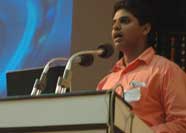
Salahuddin
Saiphy, CSE water expert, handling queries on rainwater harvesting |
Water Scenario" and highlighted the water problems faced by
some major cities of India including Delhi. He unveiled that demand
and supply gap is widening day by day in most of the Indian cities
as a result people have opted for groundwater extraction to meet
their daily water requirements. This has resulted in sharp decline
of water levels in almost every corner of the country. He called
upon to the peoples of Bhubaneshwar to realize the need of water
management and rainwater harvesting to avoid the water crisis in
near future.
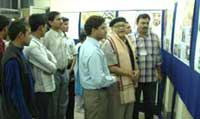
Salahuddin
Saiphy of CSE explaining the exhibition on Orissa’s State
of Environment to renowned film actor, Sharat Chand Pujari |
Student communities, who gathered in large numbers for the show, interacted
with water experts to know more about the technology and traditional
wisdom of water harvesting. Questions like can rain water be stored
for a long time? acid rain and rain water harvesting, legal safeguards
and legislation for rain water harvesting were raised by the inquisitive
viewers and answered in detail by the CSE experts. A posters exhibition
on Traditional Systems of Water Management and Orissa's State of Environment
was also put on the venue, which was inaugurated by noted cine artist
Sharat Chand Pujari, and got lot of appreciation by visitors.
Seminar for teachers on Environment Education
at Hotel Regency, Gurgaon
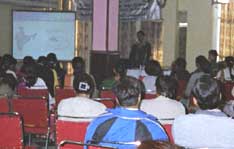 Salahuddin
Saiphy, CSE sharing the techniques of RWH
Salahuddin
Saiphy, CSE sharing the techniques of RWH |
About 85 teachers from government and public schools of Gurgaon
attended a workshop for teachers on environment education on December
08, 2005 at Regency Hotel, Gurgaon. The seminar was organised in
association with a Japanese International Organisation, OISCA -
International (Organisation for Industrial, Spiritual and Cultural
Advancement), North India. In the beginning representatives from
Japan gave a presentation on Children-Forest Programme and Action
Handbook for teachers. In Another session teachers were explained
how to reduce and recycle the solid waste generated in the school
through solid waste management.
During the post lunch session CSE staffer made a presentation on
rainwater harvesting (RWH). He revealed that the per capita water
availability in India has declined from 5177 cubic metre to 1869
in last 50 years. On the other hand domestic and industrial requirements
are growing every day. He held responsible the uncontrolled groundwater
exploitation without adequate emphasis on recharge, negligence of
urban water bodies and wasteful practices of water use for water
crisis apart from other several reasons. Later he shared the results
of regular monitoring of some of the successful projects of rainwater
harvesting (Model RWH Projects). He exposed how RWH helps to sustain
the groundwater levels and also improves water quality over a period
of time. He also explained different techniques and how RWH can
be implemented in schools with case studies. Towards the end he
also screened an advertisement on rainwater harvesting produced
by Centre for Science and Environment to promote RWH and was highly
appreciated. The seminar ended with series of queries handled by
CSE staff and vibrant discussion on how school can play an important
role in propagating this concept to larger sections of society.
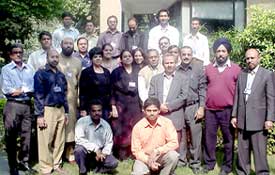 List
of participants of Training Programme on "Urban Rainwater Harvesting"
7th -11th October, 2005 at CSE, New Delhi List
of participants of Training Programme on "Urban Rainwater Harvesting"
7th -11th October, 2005 at CSE, New Delhi
Participants
list
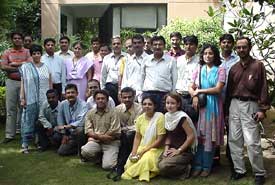 List
of participants of Training Programme on "Urban Rainwater Harvesting"
8-11 August, 2005 at CSE, New Delhi List
of participants of Training Programme on "Urban Rainwater Harvesting"
8-11 August, 2005 at CSE, New Delhi
Participants
list
New Zealand's delegation visits CSE Model Project
On September 26, 2005, a delegation form Tuakau, a small rural township
in New Zealand and the childhood home of Sir Edmund Hillary, visited
the rainwater harvesting (RWH) system of Royal Bhutanese Embassy.
Bhutan Embassy is one of CSE's Model Projects where RWH has been implemented
successfully and CSE monitors ground water levels and water quality
regularly.
The delegation included about 70 students and several teachers,
parents, High Commissioner of New Zealand Embassy- Graeme Waters
and his officials.
Salahuddin Saiphy from CSE explained the rainwater harvesting system
of the embassy in detail on the coloured panel installed in the premise
by CSE. He explained how earlier the rains in the embassy premises
use to leave the areas water logged around the entrance and officers
quarters. He also revealed that groundwater level in this part of
city is also declining rapidly due to excessive exploitation of the
water resources. Instead of letting this water flow in the storm water
drain, now the same is used to replenish the ground water with the
help of seven recharge structures constructed at strategic locations
in the premises. This has finished resulted in reducing the water
logging as well as the groundwater levels have improved a bit after
rains and almost stabilised now. The students appreciated the efforts
of Bhutan Embassy in conserving rainwater and CSE for its support
in the project. And most interestingly, Graeme Waters, High Commissioner
of New Zealand Embassy urged his officials to implement RWH in their
embassy as well.
 |
Delhi University's Environmental Society learns water management
On September 21, 2005 Salahuddin Saiphy made an audio visual presentation
on water conservation and rainwater harvesting for members of M.H.
Vatavaran, the society for environmental concerns in Miranda House,
Delhi University. He outlined the water crisis in the country in
spite of plentiful rains. He also briefed how people in different
regions have managed their water resources through rich traditional
water harvesting practises. During his presentation he explained
the principles, concepts and techniques of rainwater harvesting.
CSE's model rainwater harvesting projects were discussed in detail.
Later a film on water Water Works India: Four Engineers and a Manager
was screened to expose students to the rich traditions existing
in different parts of the country.
The session ended with a group discussion and an interactive session
in which questions raised by the students on issues like financial
assistance and mechanism of maintenance and monitoring of rainwater
harvesting systems were addressed by CSE staff.
 |
Vasant Vihar's residents realize the potential of RWH in colonies
On August 30, 2005, The ShriRam School organised an environmental
awareness programme at its Vanst Vihar campus. About 45 peoples including
representatives of RWA, teachers, students and interested citizens
attended the workshop and got know how of issues like waste segregation,
recycling, rainwater harvesting (RWH) and water conservation.
CSE staffer made an audiovisual presentation on this occasion on rainwater
harvesting focusing on how to implements RWH in colonies. He indicated
that mismanagement of water resources has resulted in series of disasters
like droughts and floods in India. He also shared that large scale
development all around the city and increasing water demands have
resulted in excessive withdrawal and limited natural recharge groundwater
resources. As a result the only source of water for daily requirement
in absence of adequate municipal water supply are under severe threat.
It is declining at a rate of 10 metres per year in parts of south
Delhi while its not less than 4-5 metres in this area as well. He
envisaged that if do not wake up and do som thing serious to replenish
these depleting aquifers, there would be no groundwater available
in these areas in recent years and rainwater harvesting is a good
tool to augment these resources. Later he spoke about the principles
and components of rainwater harvesting. He also elaborated the methods
and techniques - how to implement RWH in a colony with examples of
Panchsheel park colony, Defence colony and other successful projects
of RWH being implemented in colonies in Delhi. He also shared the
results of CSE's regular monitoring the water levels and water quality
in these projects and left the audience highly excited about RWH.
Later he screened a Public Service Advertisement on rainwater harvesting
tat was widely appreciated in propagating the concept to the larger
sections of the society. Then he handled the queries of the participants
on various issues of RWH like financial assistance, legal safeguards,
maintenance and monitoring and mostly asked the financial implication
of RWH at colony level. The workhop ended up with many citizens and
representatives of Vasant Vihar's RWA showing keen interest in implementing
RWH in the colony.
 |
Gurgaon students exposed to significance of water bodies and
water conservation practices
On July 20, 2005 Salahuddin Saiphy of Jal Swaraj Campaign, CSE,
delivered a lecture at Summer Fields School, Gurgaon on importance
of water bodies and water conservation. He explained the role of
water bodies in the hydrological system of a city and how they acted
as a structure of permanent storage of rainwater for direct use
by peoples to meet their daily requirements as well as acted as
a source of ground water recharge. He reveled that most of these
are in bad state now due to negligence of government bodies and
ignorance of citizens. The 90-second public service spot on rainwater
harvesting was highly appreciated by students as well as teachers
and other staff of the school present at the venue.
Then he outlined the water scarcity in India and reasons for the
scarcity. Uncontrolled exploitation, rampant usage, polluted water
resources were discussed citing various examples. Saiphy said that
management of water resources should be vested in the people and
explained the traditional rainwater harvesting techniques that existed
in India right from the days of Indus valley civilisation. Concepts,
principles and techniques of rainwater harvesting were elaborated
in detail. All the students energetically calculated the rainwater
harvesting potential for their school and house when they were explained
the formulae to calculate the rainwater harvesting potential for
any building
During the second session,. Later, the film Drinking the sky was
screened. The film explains nicely water problems faced by Cherapunji-
city receiving highest rain and contrastingly Atakama desert where
fog is the scanty source of water when harvested in absence of rains.
The objective of screening the films was to show the students that
the amount of rainfall is nor the criteria for any place to be water
prosperous but is the way it is managed.
 |
Scientist and Technologists gets tips on Rainwater Harvesting
On June 21, 2005, a group of scientists and technologist in
government sector benefited from the tips of rainwater harvesting
and water conservation at Centre for Science and Environment (CSE),
New Delhi. The occasion was a training programme organised by department
of Science and Technology, under Ministry of Science and Technology
in consultation with DOPT and Planning Commission.
The group was undergoing training Human Resource Development. CSE
staffer during his audiovisual presentation discussed the concept
of rainwater harvesting and explained different techniques of harvesting
rainwater. He also shared the tips of water conservation that can
be easily adopted by citizens and helpful in solving the water problems.
Participants highly appreciated the small advertisement on rainwater
harvesting screened during the programme.
 |
Students of South Asian Countries Exposed to Environmental
Issues
A group of twenty postgraduate students from South Asian countries
like Pakistan, Sri Lanka, Bangladesh and Bhutan including India,
visited CSE on May 31, 2005. Their visit was a part of excursion
organised by Friedrich Ebert Stiftung (FES), Germany. The participants
were from varied geographical, cultural and academic background.
A series of lecture, presentation and group discussion held on this
occasion exposed the students to various environmental problems
in developing countries like India. The lectures were focused on
air pollution, water conservation and rainwater harvesting.
FES is a non-profit, international NGO supported by the government
of Germany. Aiming at the strengthening of democratic structures,
the FES promotes training and policy oriented research programmes
in Germany and - in cooperation with partner organizations - in
more than 100 countries across the world. In South Asia, it has
offices in Colombo, Delhi, Islamabad and Kathmandu. Objective of
the program is to encourage participatory method of learning with
stress laid on integrating the expectations of the target group.
Anumita Roy Chaowdhry, Associate Director, Research and Advocacy
spoke about various environmental problems in developing countries
focusing on air and water. She sited the example of problems faced
during the implementation of CNG for buses and other vehicles in
Delhi. She also spoke about how the communities in India have managed
their water resources since long time and have survived well even
at the places like Thar Desert where average annual rainfall is
hardly 150 mm.
Salahuddin Saiphy of Jal Swaraj campaign also made a presentation
on rainwater harvesting (RWH). The students were surprised to see
the results of monitoring in model rainwater harvesting projects
of CSE and convinced about the potentials of RWH. The students visited
RWH system of CSE' s building with great curiosity and deeply appreciated
it.
 |
Awareness towards environmental issues for students
May 18, 2005 Centre for Science and Environment (CSE) organised an
awareness programme on environmental issues for students of various
schools of Delhi and NCR region. The programme was organised in collaboration
with National Museum of Natural History (NMNH), Ministry of Environment
and Forest, New Delhi.
The students represented various government and public schools from
Delhi, Noida, Ghaziabad and Faridabad. The occasion was a month long
vacation programme for students of age group 14-16 years organised
by NMNH. About 40 students of Class X standard attended the workshop.
CSE staffer began their audio visual presentation by screening 90
seconds public service advertisement on rainwater harvesting produced
by CSE and directed by Bollywood actress, Nandita Das. The students
highly appreciated the advertisement describing the potential of rainwater
harvesting and techniques of water conservation. A power point presentation
followed the film which exposed the students on various problems of
water specially in urban centres and rainwater harvesting as a method
to overcome the griming situation in urban centers of India. Students
were later briefed about various water conservation techniques. The
group was also demonstrated the rainwater harvesting system of CSE
building. At the end of workshop the group enjoyed a film on water,
Jal Yodha. The film speaks about traditional water harvesting practices
prevalent in different parts of India.
African Policy Makers visit to CSE
 Orientation
programme on water by Sumita Dasgupta of CSE for African delegation
Orientation
programme on water by Sumita Dasgupta of CSE for African delegation
|
A delegation of senior policy makers, bureaucrats and industry representatives
from Eastern and Southern African countries visited Centre For Science
And Environment (CSE). The delegation was led by Maimbo Malesu, Regional
Coordinator, Regional Land Management Unit (RELMA) in ICRAF, Nairobi,
Kenya. The tour was a joint venture of RELMA; a Nairobi based international
organisation and CSE, under the aegis of Global Water Partnership.
The purpose of their visit was to see the community led water works
and interact with decision-making ministers in the field of water
because there are many similarity between the conditions in two countries,
so the understanding of India's experiences in formulation of water
policy and challenges in its enforcement -including government's strategy
could be very helpful to overcome the problems in these countries.
 African
delegation interacting with Union Water Resources minister,
Priya Ranjan Das Munshi
African
delegation interacting with Union Water Resources minister,
Priya Ranjan Das Munshi |
The group represented various ministries including Ministry of Agriculture,
Department of Water Affairs, Ministry of Water, Livestock and Development,
Department of Land Rehabilitation, Ministry of Local Government and
Housing, Eastern and Southern African Trade and Development Bank (PTA
Bank), Picasso Production, Kenya Broadcasting Cooperation and Nairobi
Water Company from Southern and Eastern African nations including
Zambia, Tanzania, Kenya and Botswana.
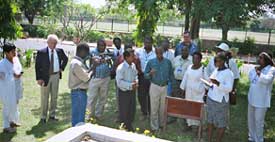 Delegation
visiting Jamia Hamdard Univeristy: a CSE’s model projects
to observe RWH in urban setting
Delegation
visiting Jamia Hamdard Univeristy: a CSE’s model projects
to observe RWH in urban setting |
On day one, they were introduced the major problems of urban centres
related to water including depleting water resources, ever increasing
demand and supply gap of water, waste water generation and dying urban
water bodies. They were also informed that focus of the government
has been on the construction of the big dams, agricultural schemes
and not on the rain fed areas since independence. There has not been
enough emphasis on the groundwater recharge and no legal and institutional
framework for community participation in the management of the resources.
They were given an overview of the evolution of the water policy in
India before the group met P R Dasmunshi, Union Minister of Water
Resources at Shram Shakti Bhawan led by CSE staff. The meeting was
very enlightening and the minister gave an overview of role of his
ministries and responded to various queries raised by the group. Ha
also informed that they are already providing consultancy on power
sector African Nations including Kenya, Tanzania and Zimbabwe.
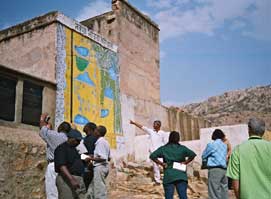 Delegation observing community water works
at Bahonta kolyala, Alwar, Rajastan
Delegation observing community water works
at Bahonta kolyala, Alwar, Rajastan |
On day two, the group was taken to Bhaonta Kolyala to see the water
works done by community, led by Tarun Bharat Sangh, an Alwar based
NGO. The group found that the work done by villagers was really interesting
and appreciable. The following day, they visited Laporiya village
in Dudu block of Jaipur (Rajasthan) where Gram Vikas Navyuvak Mandal,
Lapodiya has revived ecology of the region by developing Chauka system
on pasturelands. At the end of their visit, a core committee was formed
and an agenda was passed to identify politicians from African and
South East Asian countries who could play an active role on water
front.
 |
Exposure trip of Burmese activists
On February 21, 2005, Centre for Science and Environment (CSE)
made a presentation on techniques and success stories of rainwater
harvesting from rural and urban areas to a group of 25-30 Christian
Burmese activists. The group included senior alumni of the Grassroots
Leadership Training (GLT), who also have been involved in their
communities actively and are being trained at Ashram Wongsanit in
Thailand under a 4-month long GLT program for grass root activists
in developing countries. Their visit was a part of exposure for
the participants who already have been through this intensive program
and were visiting India. The purpose of this exposure was to give
them an opportunity to see the varied paradigms in evolution of
the social, ecological and developmental sector in other countries
and accordingly apply it in their work. The group was also shown
the rainwater harvesting structures of CSE building. The participants
showed keen interest in CSE's role in spreading awareness, research,
policy level engagement as well as community level initiatives.
 |
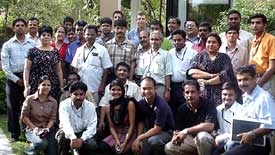 List
of participants of Training Programme on "Urban Rainwater Harvesting"
13-16 June, 2005 at CSE, New Delhi List
of participants of Training Programme on "Urban Rainwater Harvesting"
13-16 June, 2005 at CSE, New Delhi
Participants
list
 |
Vacation Program on Natural Resources at ICFRE,
New Delhi
On May 05, 2005, CSE staffer made an audiovisual presentation
on "Drinking water crisis and rainwater harvesting" at
the Indian Council for Forestry Research and Education (ICFRE),
New Delhi. The occasion was a vacation program on natural resources
organised for students recently appeared in class X examinations.
The objective of the programme was to expose the students on various
environmental issues.
Ashoka Trust for Research in Ecology and the Environment, (ATREE),
New Delhi organised a four week Vacation Program on Natural Resources
in collaboration with Ministry of Environment and Forests, Government
of India. The program selected 40 students who have recently appeared
in Class X examinations as regular students from schools in the
National Capital and Chandigarh region. These students were selected
on the basis of merit and their expressed interest on environmental
issues. The structure of the program was a constructive mix of interactive
lectures, field and institutional visits aimed at sensitising participants
on key environmental concerns. CSE was invited to make a presentation
on drinking water crisis and rainwater harvesting.
Speaking on drinking water crisis in India, Salahuddin Saiphy of
Jal Swaraj campaign CSE made an audiovisual presentation and informed
that per capita water availability in India has considerably come
down in last 50 years from 5177 cubic metre per person to 1769 cubic
metre per person. Referring to a latest assessment he told that
the availability from surface water and replenishable ground water
is about 1869 billion cubic meter (BCM) and only 60% of this can
be effectively put for beneficial use. The availability of water
is highly erratic across Time and Space, as well as Socio-economic
categories of population in the country. Pollution, scarcity of
water resources and climate change would be the major emerging issues
in the next century according to report of United Nation Environment
Programme (UNEP). Average shortfall in large towns is over 34% and
low-income groups, slum dwellers and illiterates come under the
categories of water deficient household.
He also educated the students on traditional rainwater harvesting
techniques being practiced in India since 3000 BC old Indus valley
civilization( Dhaula Veera) and their relevance in today's context.
The concept of rainwater harvesting and various techniques were
discussed in detail. He also shared some tips, if adopted in daily
activities, can be helpful in saving a considerable volume of water
during gardening, cooking, washing and in toilets. The advertisement
film screened on RWH drew the attention of participants and sensitised
them for water conservation. "Jal Yodha" a film on water
was also screened during the event. The films exposed the students
on different traditional water harvesting systems and how the peoples
have managed their water resources in the water stressed region.
 |
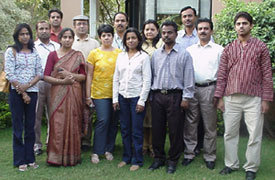
List of the participants of "Urban Rainwater Harvesting"
Training programme April 18-21, 2005, CSE, New Delhi
Participants
list
 |
Presentation at Water Technology Centre, New Delhi
On March 3, 2005 CSE staffer delivered a lecture on "Traditional
water harvesting systems of India" at Water Technology Centre
(WTC), Indian Agricultural Research Institute, New Delhi. The occasion
was a Model Training Course on "Planning & Design of Water
Harvesting Structures in Watershed Management" organised by
WTC during March 1-8, 2005. The participants were of varied interest
and geographical location mostly working on water shed projects.
Salahuddin Saiphy of Jal Swaraj Campaign, CSE, started with screening
the public service advertisement (PSA) on rainwater harvesting.
All participants were highly thrilled after seeing the advertisement.
During his audiovisual presentation, he discussed the problems why
despite of being a well endowed country with >1100 mm average
rain India faces acute water problems in many parts of the country.
He unveiled that rainwater harvesting is not a new technique; it
has existed in India since the time of Indus Valley civilization
(Dhaula Vira civilization ruminants clearly indicate that rainwater
was being stored in big tanks). Later he divided India into 15 ecological
zones and discussed traditional water harvesting practices adopted
by peoples since long time in each zone. He explained different
traditional water harvesting practices of India ranging from Zing
of Laddakh; Kundi of Jaisalmer; Surangam of Kerala; storage tanks
of Aizwal and Guhl of Himachal to Ahar - pyne of Bihar.
HE also screened the CSE's film on water -Jal Yodha, that gave a
clear picture of traditional water harvesting practices in different
parts of India. He also discussed the concepts and principle of
urban rainwater harvesting in brief. The participants also visited
CSE office on the following day to see the rainwater harvesting
system of CSE building.
 |
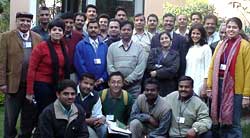
List of the participants of "Urban Rainwater Harvesting"
Training programme from February 22-25, 2005 at CSE, New Delhi
Participants
list
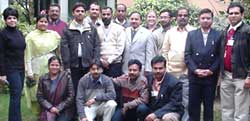
List of the participants of "Urban Rainwater Harvesting"
Training programme from January 27-31, 2005 at CSE, New Delhi
Participants
list
|
|






